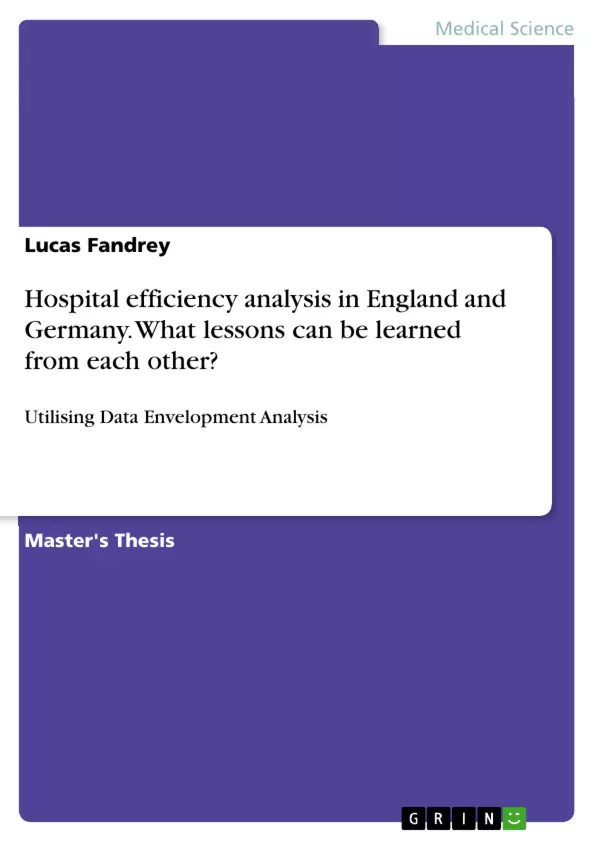This report analyses the efficiency of hospitals in England and Germany. Data Envelopment Analysis (DEA) is utilised to estimate a best practice frontier and to evaluate the performance characteristics of different hospitals in the two countries. The measurement categories of input factors are represented by the hospital size (amount of beds), number of wards, number of employed medical specialists, sum of total inpatient admissions, demographic environment (population density in population/km²), and one output factor (mortality rates).
Regarding these factors, the main findings reveal that the allocation of inefficient hospitals in England is broadly spread and, therefore, the mean efficiency value of hospitals in England is ≈44% (whereas 100% describes efficient units). In contrast, the mean efficiency value of German hospitals equates to ≈91%. Consequently, the allocation of inefficient German hospitals is less spread and the overall performance of hospital health supply is more efficient in Germany compared to England.
Most remarkably, the amount of inpatient admissions is one of the main drivers for efficiency and especially the English hospitals suffer from high numbers of inpatient admissions, which may be reduced due to improvements in the primary healthcare supply provided by general practitioners.
Inhaltsverzeichnis (Table of Contents)
- 1 Introduction
- 2 Literature Review
- 3 Research Methodology
- 4 Data Envelopment Analysis
- 4.1 Definition and Classification
- 4.2 Mathematical Fundamentals
- 4.3 Performance measurement in healthcare
- 5 Data collection and explanation
- 5.1 Hospital funding bodies
- 5.2 Identification of the measurement categories
- 5.2.1 Input Data
- 5.2.2 Output Data
- 6 Data analysis
- 6.1 Overall Efficiency Distribution
- 6.1.1 Setup
- 6.1.2 Findings
- 6.1.3 Efficiency Plot
- 6.1.4 Input and Output Relations
- 6.1.5 Efficiency Patterns
- 6.2 Efficiency Frontier 'Convex Cone'
- 6.2.1 Setup
- 6.2.2 Findings
- 6.3 Best Performance Hospitals
- 6.3.1 Reference Set
- 6.3.2 Potential Improvements
- 6.1 Overall Efficiency Distribution
- 7 Conclusion
- 8 References
- 9 Appendix
Zielsetzung und Themenschwerpunkte (Objectives and Key Themes)
This report aims to evaluate the efficiency of hospitals in England and Germany by comparing their performance characteristics. The study utilizes Data Envelopment Analysis (DEA) to determine a best practice frontier and assess the performance of hospitals across the two countries.- Analyzing the efficiency of hospitals in England and Germany
- Utilizing Data Envelopment Analysis (DEA) to measure efficiency
- Identifying key input and output factors influencing hospital efficiency
- Comparing the overall efficiency levels of hospitals in both countries
- Exploring potential improvements and best practices for enhancing hospital efficiency
Zusammenfassung der Kapitel (Chapter Summaries)
- Chapter 1: Introduction This chapter introduces the research topic and provides context for the study of hospital efficiency in England and Germany. It outlines the importance of healthcare efficiency, the need for comparative analysis, and the rationale for utilizing DEA.
- Chapter 2: Literature Review This chapter presents a comprehensive review of existing literature related to hospital efficiency, DEA methodology, and healthcare performance measurement. It explores various studies and theoretical frameworks relevant to the research topic.
- Chapter 3: Research Methodology This chapter details the research methodology employed in the study, including the selection of data, the DEA model used, and the specific input and output variables. It provides a clear explanation of the data collection and analysis methods.
- Chapter 4: Data Envelopment Analysis This chapter delves into the theoretical foundations of DEA, providing a detailed explanation of its principles, different models, and applications in healthcare performance measurement. It also discusses the limitations and considerations associated with DEA.
- Chapter 5: Data collection and explanation This chapter focuses on the data collection process, including the sources of data, the identification of relevant input and output variables, and the rationale for their selection. It presents a comprehensive overview of the data used in the study.
- Chapter 6: Data analysis This chapter presents the results of the DEA analysis, including the overall efficiency distribution of hospitals in both countries, the identification of best performance hospitals, and the analysis of input-output relationships. It explores the key findings and insights derived from the data analysis.
Schlüsselwörter (Keywords)
The primary focus of this work centers on hospital efficiency analysis in England and Germany, utilizing Data Envelopment Analysis (DEA) as the methodological framework. The study explores input factors such as hospital size, bed capacity, ward number, medical specialists, and inpatient admissions, as well as output factors like mortality rates, to assess the performance and efficiency of hospitals across the two nations. The key themes include hospital efficiency, comparative analysis, DEA methodology, healthcare performance measurement, best practice frontiers, and potential improvements in hospital operations.- Arbeit zitieren
- Lucas Fandrey (Autor:in), 2015, Hospital efficiency analysis in England and Germany. What lessons can be learned from each other?, München, GRIN Verlag, https://www.grin.com/document/317821



